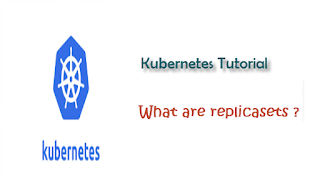Kubernetes Replicaset : introduction
Kubernetes replicaset monitors a set of pods : if a pod
crashes, the replicaset replaces it and guarantees that we have the required
number of replicas (pods).
This is the pod definition file that we created in the kubernetes pod tutorial :
apiVersion: v1
kind: Pod
metadata:
name: nginx
labels:
name: nginx
tier: frontend
spec:
containers:
- name: nginx
image: nginx
ports:
- containerPort: 80
In order to create the replicaset definition file, we will
reuse the pod definition file : we will use all the sections of the pod
definition file except the apiVersion and the kind sections.
We paste the pod definition file in the template section of
the replicaset definition file.
Also, we add two sections :
- Replicas : the number of pods that the replicaset will manage
- Selector : designs the pods that will be managed by the replicaset : those pods will have the label tier with the value frontend. If we check the pod definition part, we see that the pod has a label tier with the value frontend.
apiVersion: apps/v1
kind: ReplicaSet
metadata:
name: frontend
labels:
app: guestbook
tier: frontend
spec:
template:
metadata:
name: nginx
labels:
name: nginx
tier: frontend
spec:
containers:
- name: nginx
image: nginx
ports:
- containerPort: 80
replicas: 3
selector:
matchLabels:
tier: frontend
Kubernetes replicaset creation
We create a replicaset based on the definition file using
this command :
Kubectl create -f replicaset-definition-file.yaml
We check our replicaset using this command that lists the
available replicasets :
Scale Kubernetes pods
Now, we have 3 pods declared in the replicaset definition
file.
We aim to scale up to have 6 pods. We can do it using three
methods :
1) Method 1
- Change the replicas in the replicaset definition file
- Run kubectl replace -f replicaset-definition-file.yml
2) Method 2
- Kubectl scale –replicas=6 -f replicaset-definition-file.yml
3) Method 3
- Kubectl scale –replicas=6 replicaset frontend ( frontend : the name of replicaset in the replicaset definition file)
We will use the first method to scale our replicaset :
We check the number of pods created using the command kubectl
get pods :
We notice that we have six kubernetes pods running.
If we delete a pod using the command : kubectl delete
pod <pod_name>, we will notice that the replicaset will replace the
deleted pod :
Delete kubernetes replicaset
We use the following command in order to delete a replicaset :
kubectl delete replicaset <replicaset-name>
When we delete a replicaset, the pods that it manages will be deleted as well.
If we check the presence of these pods, we will find nothing:
This kubernetes replicaset tutorial for beginners arrives at its end.
To check our other tutorials, you can like our how to program facebook page.









Post a Comment